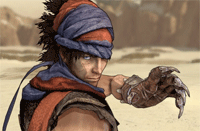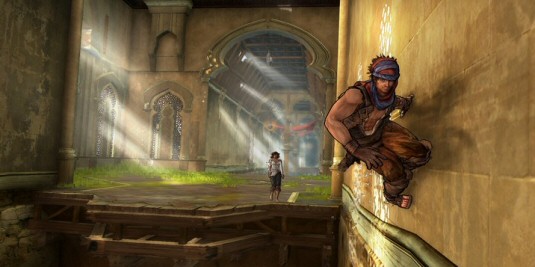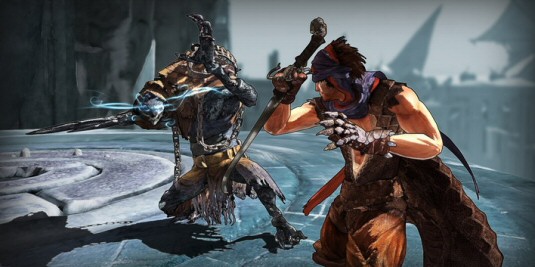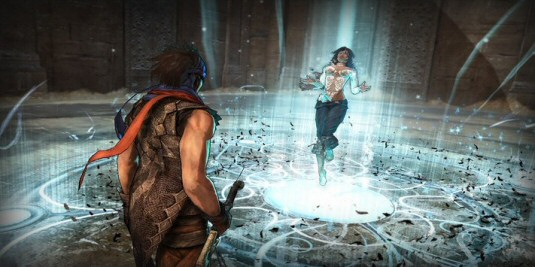Prince of Persia: A Touching Tale of Two Characters
By Jared Newman | Friday, December 12, 2008 at 10:02 am
 Sometimes, even the best games don’t reach out and touch me. The Halos, Half-Lifes and Grand Theft Autos of this medium provide an interesting window on the world, but their characters are often mere reflections of the player. For that reason, those games have a hard time conveying raw, emotional impact.
Sometimes, even the best games don’t reach out and touch me. The Halos, Half-Lifes and Grand Theft Autos of this medium provide an interesting window on the world, but their characters are often mere reflections of the player. For that reason, those games have a hard time conveying raw, emotional impact.
That’s why Prince of Persia–Ubisoft’s new reimagining of a venerable gaming franchise for the PlayStation 3, Xbox 360, and PC–is so refreshing. The game carries quite a few flaws and frustrations, but it’s the rare title that offers a little feeling along the way.
At its heart are the game’s two main characters. Of course, there’s Prince, a desert wanderer whose backstory is never quite revealed (and never mind those last few PoP remakes; they share no canon with the latest adventure). After getting caught in a sandstorm, the Prince meets an unrelated princess named Elika and gets whipped up in her unfortunate circumstances. Basically, Elika’s father revives a long-dormant evil beast named Ahriman, in turn causing the kingdom to become a dark and hideous place.

The overall goal is to fell four villains who’ve sold their souls to the evil creature. Reaching them requires a systematic recapturing of the land from “corruption” — an oozing black liquid that covers the walls and floors — broken up into two dozen regions.
Prince of Persia toggles between two distinctly different modes of play. The main thing you’ll do is travel, which would be simple if there was a reasonable amount of flat earth to stand on. Instead, most of the game world exists on walls, ceilings, poles, planks and beams, creating a virtual playground as you move from one locale to the next. The other play style is one-on-one combat. Unlike the acrobatic segments, these duels are always staged on steady ground, almost resembling fencing in the way you square off against enemies.
Despite their apparent differences, these two styles of play demand similar skills. In combat, you’ll press combinations of buttons to string attacks together. While traveling, each run along a wall or slide down a roof requires a fluid execution of specific button presses. Both cases require you to associate the right move with the appropriate sequence on the controller. You could argue that this is true with all games, but it’s hardly ever this distinct.

Elika comes into play as a sidekick rather than the cliché damsel in distress. If this leaves you shuddering from memories of Daikatana and other failed AI exploits, relax. Her use of magic can boost Prince in the air and tag-team with his attacks. It also serves as a plot device that makes dying impossible; any time Prince falls from a cliff or nears defeat at enemy hands, Elika steps in to save him. At all other times, she conveniently steps aside.
Their codependence is a driving force behind the game’s emotional charm. Elika is a foil to Prince’s nonchalance, and she’s almost put off by his inability to be serious. You get the impression that this guy’s seen a lot, and could really care less about the princess’s endangered kingdom, but he goes along for the ride because he’s a good person inside — and partly because there’s nothing better for him to do. Meanwhile, Elika is driven by the desire to restore the kingdom to its former state.
This isn’t just conveyed through cutscenes. During the game, you’re free to press a button to initiate dialogue. At times this is only good for a humorous remark, but on other occasions the two characters will enjoy long conversations. As Prince and Elika get closer to their goal, their banter becomes warmer and more playful. By the end of the game, both characters begin to expose subtle vulnerabilities, but never fully let down their guard.
It almost seems like Prince and Elika are three-dimensional characters. That’s extremely rare for a video game, and its inclusion here helps drive home some of Prince of Persia’s well-treaded themes — Light and Dark, Fate and Free Will, Change and Steady Habits. By the end of the game, you’re not so much playing to see what happens to the kingdom, but to find out what becomes of these two lost souls.

Prince of Persia is far from perfect. For starters, I found it to be laughably easy and a bit repetitive. And despite what I said about the plot, the ending should have taken a different, less “fairy tale” direction (I’ll just say that it should have ended a few minutes earlier than it did).
Still, I love the human element that pulses through this game. You may not have a life-altering revelation when it’s through, but you’ll at least feel like you did more than jump around and stab things.
2 Comments
Read more:













December 18th, 2008 at 1:49 pm
I almost completely agree with your review.
The art is just outstanding. Graphics, animations, voice acting, dialogue, story, sound effects and music fit together so perfectly that I’m willing to say to never have seen those elements ever composed so magnificently in a game.
The moment I entered the menu for the first time I somehow knew how much artistical effort was put into this piece.
Solely the gameplay itself could have been a bit more polished. The combat and traveling sequences could have been less automatized. I’d maybe even say that the occasional moments of frustration only occured due to my lack of concentration, because it didn’t really challenge me (… the moment I finally figured out how to use my parry button effectively – boy did those corrupted wipe the floor with me before that).
For me however the ending managed to be satisfying and yet build up anticipation for the sequel. I’d really like to know what actually happened to the Prince and “Why?” 😉
June 13th, 2010 at 5:03 am
Prince of Persia is definitely one of the best movies this year.:;*